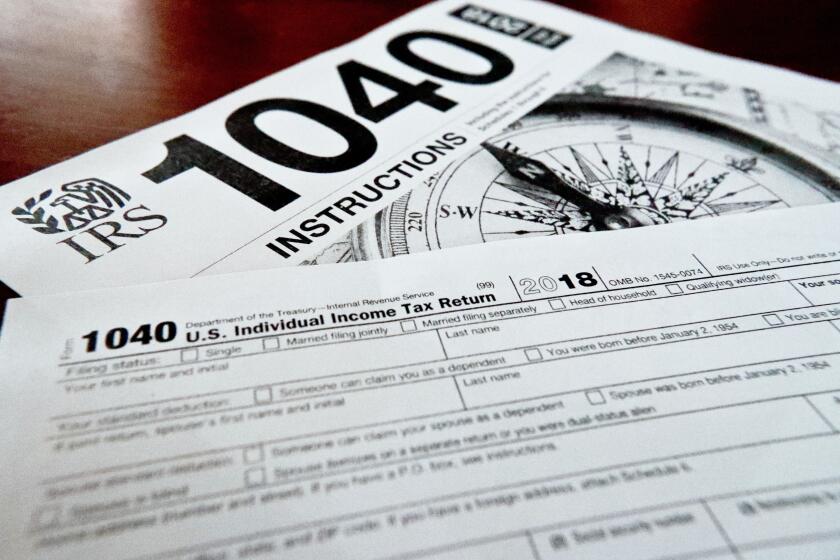Here are some tax tips for older adults

- Share via
More than half of older taxpayers (57%) are worried they’ll have to pay more taxes this year because of the 5.9% Social Security cost-of-living adjustment in 2022, according to a January survey by the Senior Citizens League, a nonpartisan seniors group.
Taxes for the over-65 set can feel more complicated for a variety of reasons: There are often multiple streams of income, some retirees still work part time, and people may be managing required minimum distributions from retirement accounts.
“It can happen that people have more income in their later life than they did when they were working,” said Barbara O’Neill, a certified financial planner in Ocala, Fla., and the author of “Flipping a Switch: Your Guide to Happiness and Financial Security in Later Life.”
For older adults, here are some items to keep in mind this tax season:
Medicare thresholds matter
Your income can affect your Medicare Part B and Part D premiums in the future because of the income-related monthly adjustment amount, or IRMAA. Medicare premiums are based on your tax return from two years prior, and you may have to pay more if your income exceeds certain thresholds.
Unlike a deduction, which decreases the income on which you’ll be taxed, a tax credit reduces your overall tax due.
These IRMAA surcharges can be difficult to manage “because they operate as a cliff, not a phase-in,” said Edward Jastrem, a certified financial planner in Westwood, Mass. “For example, if you are $1 over an income tier, you are subject to the full surcharge.”
In 2023, people filing individually with modified adjusted gross income of more than $97,000 in 2021 — or jointly with more than $194,000 — will pay higher monthly amounts for Medicare. “Tax bracket management becomes crucial in later life,” O’Neill said.
Required distributions can go to charity
At age 73, you are required by the IRS to start taking required minimum distributions from tax-deferred retirement accounts. But once you hit age 70½, you can have some or all of your required minimum distributions sent directly to a charity of your choice. This move will still count as a required minimum distribution, but the amount isn’t added to your taxable income.
“If you take a regular RMD from your IRA, it gets added to your adjusted gross income for tax purposes,” said Ian Weinberg, a certified financial planner in Woodbury, N.Y. “It usually throws you into a higher bracket.”
Many software options will let you file your taxes and get your tax refund for free. And for most Californians, the tax deadline has been moved to Oct. 16, 2023, to file federal and state.
Sending money directly to charity is called a qualified charitable distribution, and you can do this with up to $100,000 of your annual required minimum distributions.
Side businesses change the tax approach
About 1 in 4 adults 50 and older say they’re doing gig work or freelancing, according to a January survey from AARP.
If you’re doing gig work, that counts as business income — which means you can deduct business expenses. This includes health insurance premiums if you’re paying for your own insurance. “Self-employed older adults on Medicare can deduct Medicare premiums for themselves and their spouses against business income,” O’Neill says.
Other deductible expenses may include business supplies, home office costs and advertising expenses, which may include costs to run a website.
If you earned a bank sign-up bonus or interest, you need to set aside some for taxes. Credit card bonuses are not taxable because they are considered spending rebates.
Social Security may be taxable
Many people don’t realize that Social Security benefits are taxable if your income meets certain thresholds. “That takes people by surprise,” said Nadine Burns, a certified financial planner in Ann Arbor, Mich.
The taxable portion of your Social Security benefits is based on your combined income, which is the total of your adjusted gross income, nontaxable interest and half of your Social Security benefits. If you’re filing taxes as an individual and your combined income is over $25,000 — or over $32,000 if you’re filing a joint return — you could pay income tax on up to 50% to 85% of your benefits.
Ashford writes for personal finance site Nerdwallet. This article was distributed by the Associated Press.
More to Read
Inside the business of entertainment
The Wide Shot brings you news, analysis and insights on everything from streaming wars to production — and what it all means for the future.
You may occasionally receive promotional content from the Los Angeles Times.













